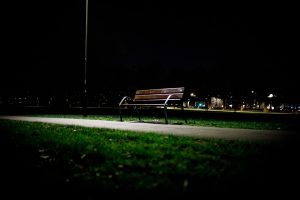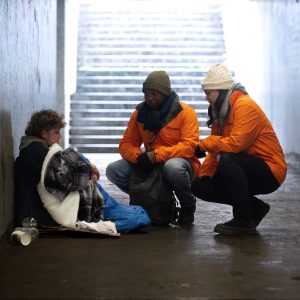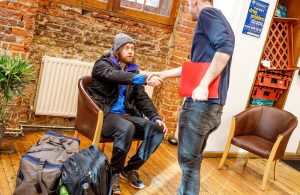Winter is one of the toughest times for people experiencing homelessness. The freezing temperatures, damp conditions, and harsh weather increase the risk of serious health issues like hypothermia, frostbite and other health complications. In this article, we reflect on how St Mungo’s adapts services during extreme weather conditions, with insights from colleagues and some of our clients.
Throughout the colder months, St Mungo’s worked tirelessly to bring people off the streets and into safety. Now, as we welcome spring, the weather may be improving, but the need for support remains. Sudden cold snaps, heavy rainfall, and unpredictable conditions can still put people sleeping rough at risk. Our work continues year-round to ensure that no one is left without shelter, whatever the season.
In this article, we reflect on the work that we do, with insights from colleagues and some of our clients.
“Here at St Mungo’s, the cold season is another opportunity to engage with people, and for volunteers to experience the work we do and how humanity is at the centre of what we do,” says Hannah Faulkner, our Head of Rough Sleeper Services.
What is SWEP, and Why Does It Matter?

SWEP means Severe Weather Emergency Protocol, The Local government activates it when temperatures fall below zero, or when weather poses a risk to life. The process focuses on saving lives. It ensures that anyone sleeping rough is offered an emergency shelter.
The Pan London SWEP service, commissioned by the Greater London Authority (GLA) and supported by St Mungo’s, is part of this initiative. This protocol, combined with our dedicated frontline workers and service managers, helps bring as many people to safety as possible.
New data released on 31 January 2025 by the Combined Homelessness and Information Network (CHAIN) which covers October to December 2024, shows that 4,612 people were recorded as rough sleeping in London between October to December 2024. This is an increase of 5% on the same period last year.
The data also shows that during this period:
- 2,115 people were rough sleeping for the first time, a 7% decrease from 2023
- 1,872 people were intermittently rough sleeping, 16% higher than last year
- 704 people deemed to be living on the streets, a 26% increase, and;
- 1,767 had a mental health support need, 50.1% of the total number of people rough sleeping
The Role of Frontline Workers During SWEP

Frontline workers play a critical role in ensuring the success of SWEP. Outreach teams hit the streets day and night, with a mission to connect with individuals sleeping rough.
Adeola, who worked with our outreach teams this winter said: “Winter is an incredibly tough time for the people we support. When SWEP is activated, my job is to go out and make sure no one is left behind. We approach people gently, offering them a warm place to stay and some hot food. Most of the time, they’re relieved that someone cares enough to reach out.”
During a chat with Alisha, who is part of the Oxford Street Population Outreach Team (OxSPOT), she gave us some insights:
How does your team prepare for SWEP activations and work with other services?
Preparing for SWEP means knowing who is rough sleeping, where they are staying, their support needs, and any risks. We also keep track of their contact details.
We monitor referrals and ensure we know where clients are sleeping and any risks they may face. Our team meets to plan who will contact or locate each client. When SWEP starts, it becomes our top priority, so we pause other casework to focus on it.
What challenges do you face during SWEP and how do you solve them?
The biggest challenge is contacting clients. Some are hard to reach, so we spend a lot of time trying to find them. Another challenge is speaking to clients who refuse SWEP support. We explain the dangers of sleeping outside in the cold and why shelter is crucial for their health. We also face challenges in finding the right accommodation for clients, based on their needs and risks.
Can you share a success story from SWEP?
SWEP can help clients who haven’t been inside for a while or have refused shelter before. They often realise the benefits of being indoors, which can lead to longer-term solutions.
SWEP helps us connect with new clients, allowing us to assist them in finding accommodation and support from other services.
In the latest SWEP activation, Oxford County Council’s team worked closely with us. This led to more clients receiving priority placements in hotels. This helps us engage with them longer to ensure they do not return to rough sleeping.
Do you make sure clients receive long-term support after SWEP? How?
Yes. Clients who join us during SWEP get continued support from St Mungo’s and other services. We help them work towards solving the issue of homelessness in the long term.
What is the most misunderstood part of SWEP?
Clients often think that the SWEP shelter is permanent housing after SWEP ends. They also assume hotels are always available. Another common misconception is that SWEP only operates when temperatures fall below freezing. Finally, clients think that no help is available after 5 pm. In Oxford, clients can still get help after 11 pm and find a place to stay in the cold.
The teams work closely with local councils and other organisations. They ensure there are enough emergency bed spaces available. We handle interactions with care and sensitivity. We recognise that building trust is essential for individuals who have experienced trauma.
Inside the Emergency Shelters

When individuals arrive at emergency shelters, welcoming colleagues greet them warmly. Shelters provide a safe place to sleep. They offer hot meals and access to essential services. These include long-term housing options, healthcare, and mental health support.
Adesewa, a Night Reconnection Worker reflects: “There are nights when it feels overwhelming. You see so many people in need, and it’s hard not to wish you could do more. But knowing that we’ve helped even one person find safety keeps us going.”
Theresa, another Night Reconnection Worker spoke with us in detail:
Can you describe the atmosphere in the shelters during a SWEP activation?
“The atmosphere during the SWEP activation was warm, welcoming, and supportive. The shelter was clean and cosy, offering a safe and comfortable space for clients in need. We made sure that essential provisions were available. Many clients arrived feeling cold and hungry. We provided hot meals, blankets, and a place to rest. It helped give them a sense of security during a difficult time. The overall environment was one of care and compassion, ensuring that everyone felt looked after.”
How does it feel to know your work directly saves lives during harsh weather?
Knowing that my work directly saves lives during harsh weather is incredibly humbling and fulfilling. Being able to offer shelter, warmth, and comfort during such challenging times is a reminder of the impact we have on people’s lives, and it reinforces the importance of the work we do. It feels truly rewarding to know that, in those moments, we are providing more than just physical shelter – we’re offering hope and a chance for people to rebuild.
Collaboration and Logistics
SWEP relies on effective collaboration between multiple stakeholders, including local councils, community organisations, and clients themselves. Coordinating these efforts is no small feat, but the shared commitment to saving lives keeps everyone focused on the goal.
Challenges and Resilience
SWEP comes with its challenges. Limited resources, logistical complexities, and the sheer number of people experiencing rough sleeping can strain even the most prepared teams. Despite these obstacles, the resilience and determination of St Mungo’s colleagues shine through.
Hannah Faulkner – our head of Rough Sleeper Services, provided some insights on the activities that go on behind the scenes during SWEP:
What are some of the biggest challenges you face during SWEP?
Making sure we have enough provision across London is a real priority and something that needs to be discussed and planned ahead of severe weather. Secondly, move on options for people once SWEP is deactivated is also a real challenge for us. At No Second Night Out (NSNO), we abide by the ‘in for good’ principle which means that if a client engages with us when they arrive during SWEP and wants to work with us, they can stay until we are able to successfully support them into suitable accommodation. With limited move on options available, we must work extra hard to find these additional move options for clients to ensure they do not return to rough sleeping.
How do you overcome them?
We hold meetings with boroughs, work with the GLA and other providers, and use data from CHAIN to show the demand for emergency support. At St Mungo’s we have been creative with using voids and spaces across our services as emergency shelter. We advocate for those most vulnerable for their local authority to place them in accommodation and support them longer term. When our spaces are filling up, we must look where and how more bedspaces can be opened for more people to ensure that all those that need it can access shelter during extreme weather.
How do you ensure that individuals brought into SWEP receive not only immediate care but also pathways to long-term support?
The unique thing about NSNO Pan London SWEP is that clients are not treated differently, they get the same assessment and care that the service users get. So, in terms of move on, we assess and support their move on plans. We’ve had good success with that.
What do you think is the most misunderstood aspect of SWEP and the work involved?
SWEP is an emergency and yes there is a genuine risk of death to those that rough sleep. But at St Mungo’s, we know this risk is real all year round. We are proactive with this because we understand that people experiencing homelessness are vulnerable at any time of the year. However, when it’s cold, it’s an opportunity to flag the dangers. Therefore, we highlight that SWEP for us is not the only time we pay more attention. It is an additional layer to what we do, not just when it’s cold.
Feedback from people supported by SWEP
Hearing directly from individuals who have accessed SWEP services underscores its importance. Many express gratitude not just for the physical relief but also for the sense of dignity and respect they’re shown.
Some clients who have spent several winters on the streets, shared that it was not just about the warm bed. It was about feeling human again. They mentioned that the St Mungo’s teams didn’t just see them as a statistic, but they felt seen as people who deserved kindness.
One person who was supported into a SWEP service and subsequently engaged with St Mungo’s said: “I was sleeping in the park when Outreach team found me and brought me here. I felt safer, as you know the cold can be dangerous. I stopped worrying about how to survive through the dangerous weather. I also officially got support from St Mungo’s. I have been supported by the team in my journey to find a suitable accommodation.” Read more real-life stories from our clients.
Long Term Impact of SWEP
While SWEP is primarily a short-term emergency measure, it can serve as the first step toward long-term support. Once individuals come into shelters, they work with caseworkers to access housing, healthcare, and other services aimed at breaking the cycle of homelessness.
More clients from SWEP have said that it was the turning point for them. It supported them away from the streets and into a space where they could start thinking about the future. From there, St Mungo’s helped them to find permanent housing and a job.
How You Can Support SWEP
Extreme weather can be dangerous at any time of year. St Mungo’s is committed to ensuring that no one has to sleep rough during harsh conditions, but we can’t do it alone. Your support helps us provide life-saving services, not just in winter, but all year round.
Ways to support include:
Donating: Your contributions help fund emergency shelters, supplies, and outreach efforts. To donate, click here.
Volunteering: Join our team and make a direct impact by supporting those in need.
If you know someone who is at immediate risk of sleeping rough, please contact StreetLink online or by calling 0300 500 0914. They will then forward the referral onto our outreach teams. Please note that StreetLink is not an emergency service. If you are concerned about someone’s health, please dial 999.
Together, we can provide warmth, safety, and hope to those who need it most—no matter the season.
